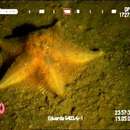Distribution
provided by EOL authors
Hymenaster pellucidus is a deep-sea species typically found in the North-west Atlantic and Arctic Oceans (Sibuet 1979, Piepenburg 1997). Some other species within the same genus occur in other deep-sea regions of the world. There may be some taxonomic confusion and synonomy around the genus Hymenaster in the Atlantic, with H. pellucidus restricted to the Northwestern Atlantic Ocean and H. membranaceus typically found in the north-eastern Atlantic deep-sea (Pain et al. 1982). The most western Arctic record is probably one individual found at about 2,500 m depth in the Arctic Canada Basin (MacDonald et al. 2010)
General Ecology
provided by EOL authors
Hymenaster pellucidus Wyville Thomson is a spinulosan sea star (class Asteroidea). It is characterized by its gelatinous and translucent body wall that allows the underlying internal skeleton to shine through. The skeletal arrangement is quite distinct from the typical asteroid skeleton with very long lateral spine projections. The gelatinous body wall is fragile and is often destroyed when individuals are collected with trawls. The more recent use of remotely operated vehicles has allowed researchers to observe this species and congeners in their natural environment. The species seems to be able to produce large amounts of mucus released from an opening on the aboral side, which may be defense mechanism against predators. Even the earliest records suggested that H. pellucidus is a brooder (Thomson 1878), and it has since been confirmed that this species broods its fertilized eggs under its supradorsal membrane until fully developed small juveniles hatch (Clark and Downey 1992). This is not an untypical reproductive mechanism in deep-sea invertebrates. There currently is very little information on what they eat or which ecological role they fulfill in the deep-sea environment.

